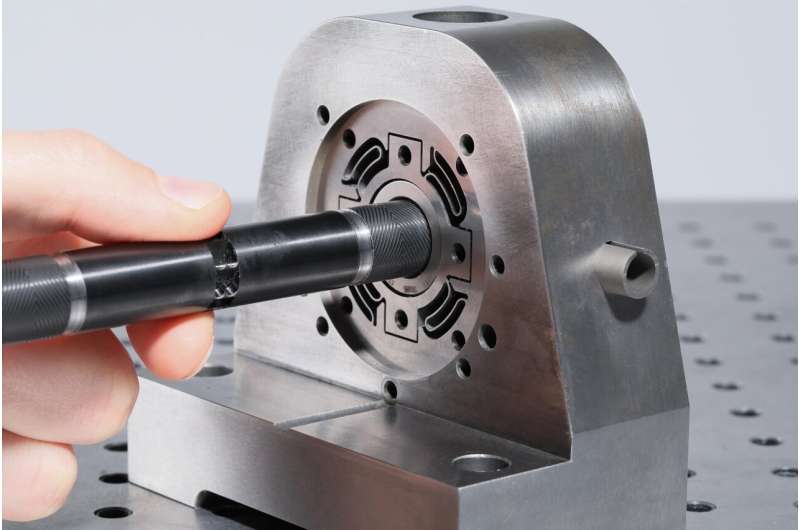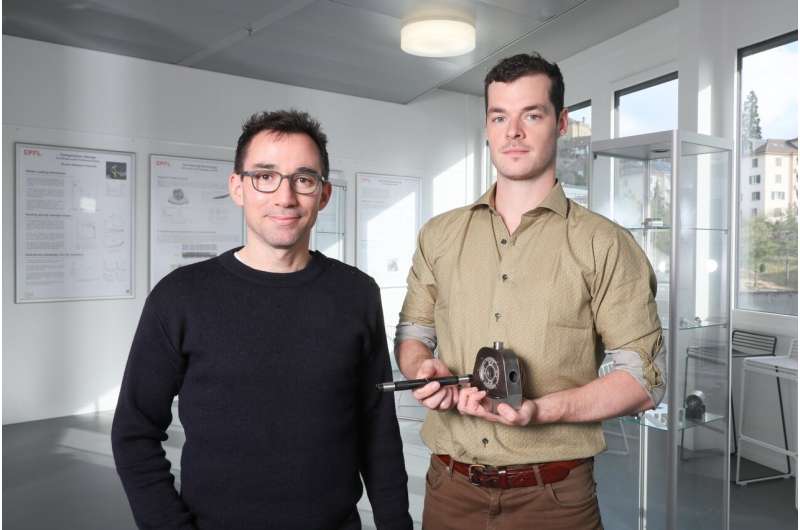Scientists finally confirm a 50-year-old theory in mechanics

An experiment by EPFL researchers has confirmed a theory that has been used in mechanics for over half a century—despite never having been fully validated. The team could now use the theory in bolder and more innovative ways in their quest to develop ever better energy systems.
Some theories are widely used even though they have never been experimentally validated. One example is the so-called narrow groove theory, or NGT, which explains how air-lubricated bearings work in mechanical systems.
The theory was proposed in 1965 but, until recently, it had only been tested partially or indirectly. Researchers at EPFL's Laboratory for Applied Mechanical Design (LAMD), based at Microcity in Neuchâtel, have now closed a gap that has persisted in the scientific literature for over 50 years. The team has published its findings in the journal Mechanical Systems and Signal Processing.
Why did it take so long to validate the theory? "At the time, engineers were content to observe that the theory worked," says Eliott Guenat, a doctoral assistant at EPFL and the paper's lead author. "But that's all changed, because the mechanical parts we're developing today are much more advanced and intricate."
The narrow groove theory was proposed in 1965 by J. H. Vohr and C. Y. Chow, two engineers at New York-based Mechanical Technology, Inc. The theory explains the working of herringbone grooved journal bearings, or HGJBs—a type of air-lubricated bearing that supports rotating parts in mechanical systems. Many different types of bearings exist, but HGJBs hold the most promise for developing ultrahigh-speed rotating machines because the rotor is supported on a cushion of air generated by the rotating shaft. "What makes HGJBs special is that they don't cause wear and tear because there's no contact," explains Jürg Schiffmann, who heads the LAMD. "In my lab, we're using this design to develop the energy systems of the future."
Validating the theory
To validate the narrow groove theory, the researchers mounted a rotor supported by several HGJBs on a test rig, setting it spinning at 100,000 rotations per minute. Next, they used a shaker system to vibrate the rotor and watched how it reacted. The observations allowed them to calculate the bearings' stiffness and damping coefficients, which they compared against the theory's predictions. They found that NGT tended to marginally overestimate both values.
"We were able to quantify the extent to which the theory holds," says Guenat. "Now that we've shored up our understanding, we can take the theory and apply it in industry and research in new ways."
Guenat plans to conduct more experiments to take further measurements. "Instead of using air-lubricated bearings, we'll run the experiment again with refrigerant, a gas used in heat pumps," he explains. "The idea is to confirm that the theory holds not just in air, but also in a medium with markedly different chemical and physical properties."

Elegant in its simplicity
NGT is a mathematically elegant theory that would likely never have seen the light of day had engineers only now taken an interest in air-lubricated bearings. "These days, we feed our data into a computer and let the processor do the heavy lifting," explains Guenat. "But even with modern processing power, arriving at the result would take several minutes. With NGT, we can do the same in just a few seconds." The fully validated theory could have innovative applications in energy system design.
More information: Eliott Guenat et al. Dynamic force coefficients identification on air-lubricated herringbone grooved journal bearing, Mechanical Systems and Signal Processing (2019). DOI: 10.1016/j.ymssp.2019.106498




















